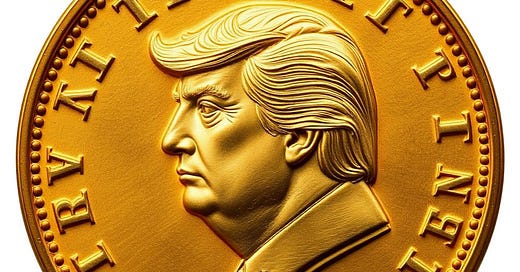Reviewing the coinage of the Roman emperors offers a very different perspective on their historicity, as we can study the evolution of numismatic iconography in comparison to the official historiography handed down by the likes of arch gossips like Suetonius. For now we will ignore the coins of Julius Caesar and begin our study with the coins of Augustus Caesar. Josephus claims that Augustus ruled for 57 years, meaning he began his reign at a very young age, and indeed we see a young man on his first coins. We will restrict the following comparison to gold coins or aurei.

The above is one of the earliest coins of Caesar, aligned with his defeat of Egypt at the Battle of Actium in 31 BC and the death of Cleopatra in 30 BC. The reverse says “CAESAR DIVI F”, short for Divus Filus or Divine Son. He is not yet called Augustus.

Note in this later issue from 19 BC not only the slim, youthful visage of the Emperor, but the placement of his name between two laurel branches on the reverse. This iconography of “between two laurels” occurs on other coins upon the Altar of Lyon, reflecting Tertullian’s enigmatic reference to the assassination of a Caesar: “Whence, then, came a Cassius, a Niger, an Albinus? Whence they who beset the Caesar between the two laurel groves? Whence they who practised wrestling, that they might acquire skill to strangle him?” Cassius is known as an assassin of both Julius Caesar and Caligula, yet Tertullian fails to mention Julius Caesar at all. In fact, in the same paragraph, Tertullian says of Caesar’s assassins, “no doubt they were in the habit of calling Christians enemies of the state.” This eliminates the possibility that Tertullian refers to Julius Caesar, who died in the century before Christ.
The Ancient Roman Coin website shows 99 different gold aurei issued under Augustus, a solid indicator of his affluence and the length of his reign.

The above issue shows an altar on the reverse saying “FORT RED” as well as “CAES AUG” and “S.P.Q.R.” According to wikipedia, FORT RED is short for Fortuna Redux, a goddess introduced in 19 BC to celebrate the return of Augustus from Asia Minor. Next up is a coin from the end of Augustus’ reign, c. 14 AD:
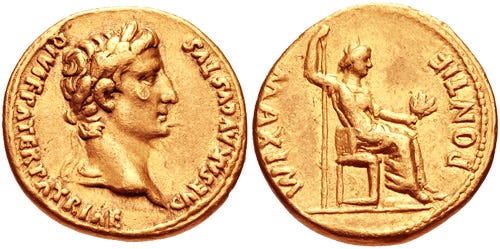
The obverse of this coin reads “CAESAR AVGVSTVS DIVI F PATER PATRIAE” as in Divine Son, Father of the Fatherland. Reverse says “PONTIF MAXIM, as in Pontiff Maximus, the head of the Roman religion. The face of Augustus has clearly matured.
Next up is a coin of Augustus’ successor Tiberius. Whereas 99 different gold coins are shown for Augustus, Tiberius yields only 7. Some are similar to the coin of Augustus shown above, with seated female figure and “PONTIF MAXIM”. The following coin has the head of Tiberius on one side, and Augustus on the other. Augustus as the “divine son” is shown with a star above his head, the same iconography associated with Julius Caesar. The obverse says “TI CAESAR DIVI AVG F AVGVSTVS” and the reverse “DIVOS AVGVST DIVI F”. Minted at Lugdunum (Lyon), 14 AD -37 AD.

And now follows an aureus of Tiberius’ successor Caligula or Gaius Julius Caesar. Obverse says “C CAESAR AVG GERM P M TR POT COS”. Reverse again depicts Augustus Caesar, now with two stars about his head and a radiate crown. Other coins of Caligula show Agrippina or Germanicus on the reverse.
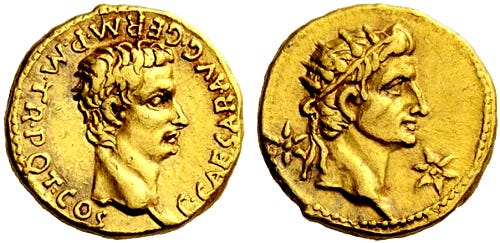
Next up are the coins of Claudius, with 43 examples of gold designs, more than Tiberius and Caligula combined. Claudius is an interesting focal point because church father Tertullian leaves him out of his list of Emperors, skipping from Caligula to Nero. Meanwhile church father Theophilus says Claudius reigned for 23 years, while official history accords him only a 13 year reign. Claudius’ coins show a great diversity of images. Some feature Constantia, some a triumphal arch saying De Germanis or De Britann, others the goddess “Pax-Nemesis”, others the head of Nero.
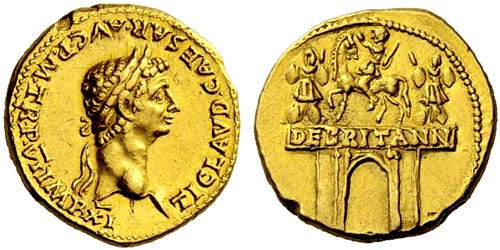
Note in the above image how the triumphal rider is placed on top of the arch, between two trophies or tropaion which resemble crucifixes. Other issues show bound captives at the feet of the trophies. Meanwhile Jesus Christ was supposedly crucified between two thieves. Obverse says “TI CLAVD CAESAR AVG P M TR P VI IMP XI”, a good reminder that Tiberius was also the name of Claudius. Reverse says “DE BRITANN”.
This brings us to that most infamous of emperors, Nero, who Tertullian claims was the direct successor of Caligula. Like Caligula’s coins which often feature Agrippina, the coins of Nero often feature Agrippina II. Here is an early issue dated to 54 AD:

The obverse says “AGRIPP AVG DIVI CLAVD NERONIS CAES MATER” and the reverse says “NERONI CLAVD DIVI F CAES AVG GERM IMP TR P”. Just as Claudius is credited with minting coins of Nero, Nero is credited with minting coins of Divus Claudius. As usual the names of emperors fall into significant confusion.
But then something changes, because by 66 AD Nero gets FAT:
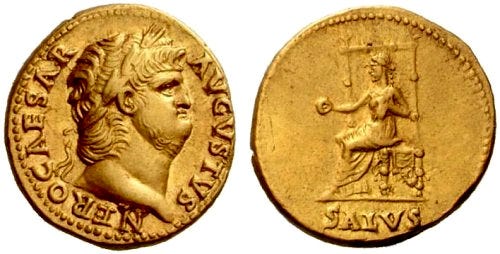
The death of Nero brings us to the first civil war of the Roman empire and the Year of Four Emperors, after which Vespasian founded the new Flavian dynasty. According to official history, the emperor Galba ruled only 7 months up to January of 69 AD. Yet he has no less than 34 gold coin designs attributed to him. Square this information with Tiberius Caesar, who ruled for 23 years yet only has 7 gold coin designs. Furthermore Galba appears to age quite a bit in his coins. Compare the following:
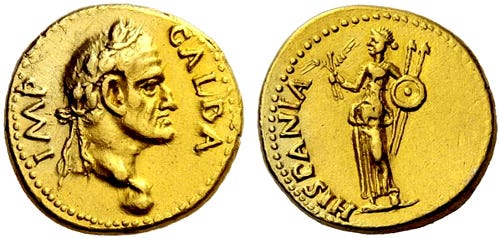

It certainly didn’t take long for Galba to accumulate some neck rolls and jowls. However, Galba’s eventual flabbiness can’t hold a candle to his successor Vitellius, who only ruled for only 8 months yet also accrued 31 gold coin designs:

And then there is the third of the Four Emperors, Otho, slightly less rotund:

And finally the triumphant Vespasian, reprising the imagery of Pax-Nemesis:
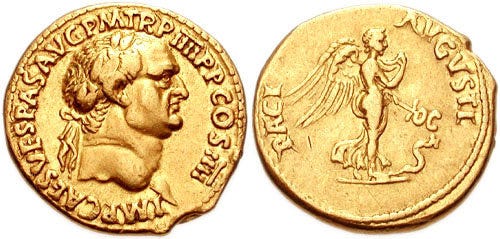
And Vespasian’s son Titus, looking like Nero, credited with dismantling the “second” temple in Jerusalem as predicted by Jesus Christ in the gospels:
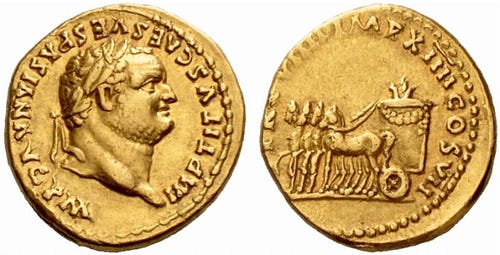
After Titus, Domitian slimmed down a bit to conclude the Flavian dynasty, while the succeeding Nerva-Antonine dynasty including Marcus Aurelius returned to the svelte form of the early Julio-Claudians. It seems civil war is associated with fat emperors. Which makes me slightly concerned about this guy:
How long until the Year of Four Presidents?

